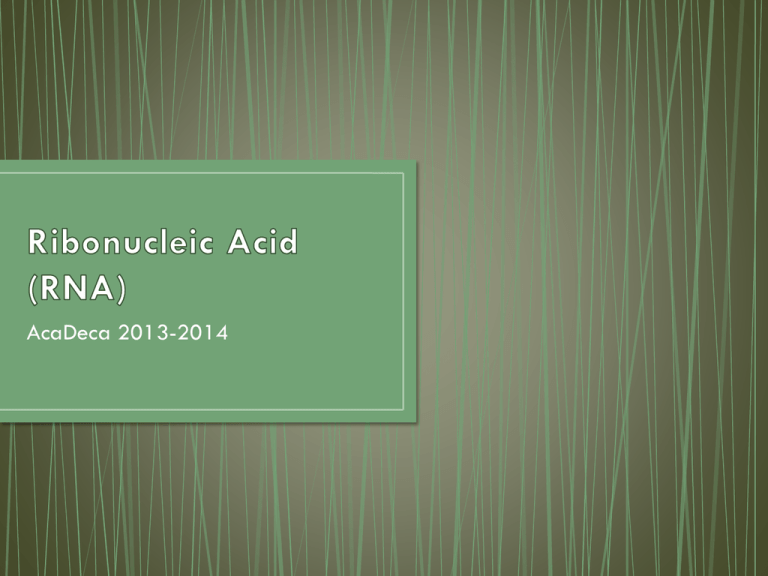Ribonucleic Acid (RNA)
advertisement

AcaDeca 2013-2014 RNA is similar to DNA except for the fact that: • RNA’s sugar is ribose • One of the nitrogenous base is uracil • It is typically single stranded • Smaller than DNA • Ribosomal RNA (rRNA) • Made in the nucleolus inside eukaryotic cells; complexes with dozens of proteins to form ribosome that holds mRNA and tRNA in the tight orientation for translation, or for protein synthesis to occur • Messenger RNA (mRNA) • The transcriptional product of specific genes in DNA; carries information as codons from DNA to ribosome to be translated into specific amino acids • Transfer RNA (tRNA) • Carries specific amino acid and partners with mRNA by way of complementary pairing to the codon on the mRNA; the triplet nucleotide sequence produced is called the anticodon • All 3 types are made in the nucleus • Same basic structure • Polymer of mononucleotides consisting of a phosphate, ribose, and one of four nitrogen bases (A,U,C,G) • Single stranded with the exception that tRNA can be double stranded • In this case it follows the similar base pairing rules as with DNA • Bounded by hydrogen bonds • Three major steps: • Initiation- DNA is separated into a single strand and bound by a RNA polymerse • Elongation- A,U,G,C is added based on the DNA sequence • Termination- as the RNA grows, completed segments seperates from the DNA sequence • After transcription, a cap (extra nucleotides) and a poly tail (long nucleotides consisting of A’s) are added at boths ends of the mRNA • The removal of noncoding region, which consist of introns and exons, must happen in order for the mRNA to be usable. • Introns are excised • Exons have to be stitched together • There are three stages of translation: • Initiation- begins when mRNA, small and large ribosome subunits, and the first tRNA carrying an amino acid sequence. This complex allows an anticodon to be formed. • Elongation- growing peptide chain forms with the repeating of the mRNA binding with the small subunits, allowing the tRNA to form the anticodon, and finally the anticodon going to the large subunit to wait for other tRNA’s to enter. • Termination- elongation process continues to occur until a STOP codon is encountered. Once this happens the chain disassociates from the ribosome and the entire complex disassembles. • Modifications occur as the protein travels to it’s destination • Some modifications include removal of certain amino acids, addition of carbohydrates, lipids, functional groups, disulfide bridges, or metal ions. • “RNA is believed that it may have been the first genetic material” • Arthur Kornberg & Severo Ochoa were credited for working out the biosynthetic pathway of DNA and RNA • Roger Kornberg was credited for working out how information from DNA is transcribed to messenger RNA during transcription • Thomas Cech and Sidney Aktman proved that RNA was the first genetic material but studying the self-splicing properties involved in post-transcriptional RNA. RNAse • miRNA (micro RNA) and siRNA/RNAi might be involved in defending against cancer and DNA/RNA viruses • ATP (responsible for energy) is related to RNA




